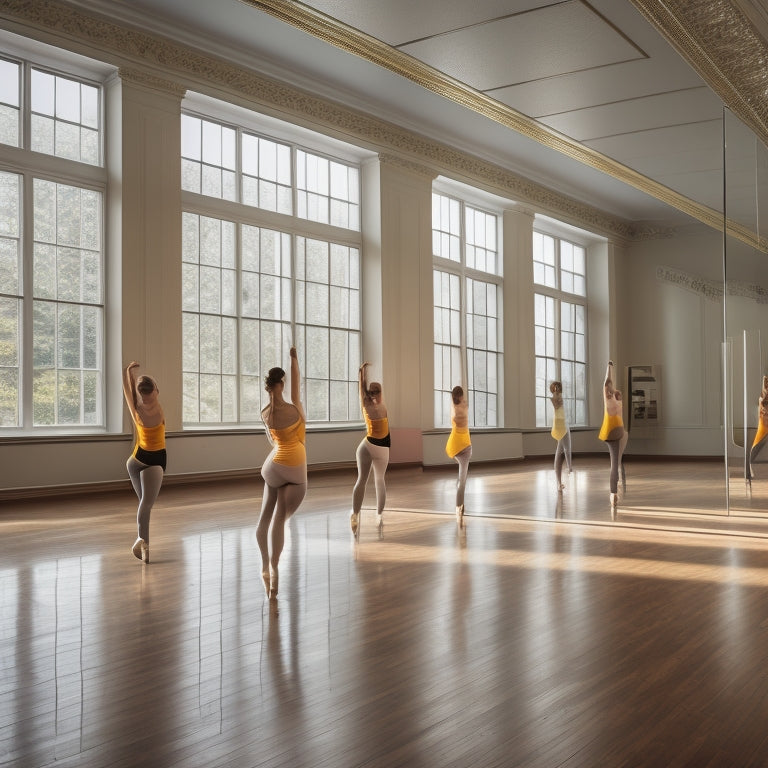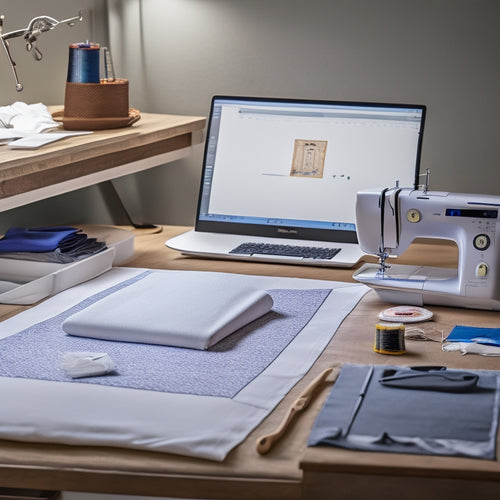
Top 7 Ballet Barres for Dance Studios: A Comprehensive Guide
Share
When choosing a ballet barre for your dance studio, consider the importance of sturdy support, adjustable height, and non-slip grip to prevent muscle strains and falls. A well-designed barre can greatly enhance your dancers' performance and safety, catering to various ages and skill levels. You'll need to evaluate barre types, materials, and mounting options to find the perfect fit for your studio. Examining the durability, aesthetics, and functionality of the barre will guarantee you make the right investment. From freestanding to wall-mounted options, and different materials like wood, metal, or fiberglass, the options are numerous, and a closer look at each will reveal the perfect choice for your studio.
What You Need to Know
- Durability and sustainability are crucial factors when evaluating ballet barre types, such as wood, metal, or combination materials.
- Freestanding and wall-mounted options cater to different studio needs, with weight capacity and flooring type considerations.
- Adjustable barre heights are essential for accommodating various ages and skill levels, typically ranging from 30 to 46 inches.
- Non-slip grip and improved traction control enhance dancer safety and confidence, with textured surfaces and rubber coatings being effective.
- Material choice, such as wood or metal, impacts aesthetic appeal, durability, and performance, with wood offering a secure grip and cost-effectiveness.
Sturdy Support for Dancers
When selecting ballet barres for your dance studio, you'll need to evaluate the barres themselves as well as the mounting options to guarantee sturdy support for your dancers.
You have several choices for barre types, including wood, metal, and a combination of both, each with its own durability and design considerations. High-quality materials like premium materials promote sustainability and are essential for the stability of ballet barres.
Sturdy, heavy-duty materials withstand frequent use, assuring safety, while eco-friendly options contribute to a healthier environment. By assessing the materials and construction of the barres, you can choose an option that meets your studio's specific needs and provides reliable support for your dancers.
Barres and Mounting Options
A sturdy barre is vital for dancers, providing the support and balance needed to perfect their technique. When choosing a barre, you'll also need to take into account the mounting options that best fit your studio's needs.
Wall-mounted barres are ideal for studios with limited floor space, as they don't obstruct the dance floor and keep the area clear for other activities. On the other hand, freestanding barres offer more flexibility and can be easily moved or rearranged to accommodate different class formats or events.
When it comes to installation, reflect on the barre's weight capacity and the type of flooring in your studio.
You'll also want to contemplate the barre's aesthetics and how it will fit in with your studio's overall design. Look for a barre that isn't only functional but also visually appealing, with a sleek and modern design that complements your studio's decor.
Durability and Design Considerations
Choosing a barre that can withstand the rigors of daily use is essential, as it directly impacts the safety and performance of your dancers. When evaluating durability, you'll want to take into account the material and construction of the barre. Look for high-quality materials that offer peak strength, stability, and material longevity.
| Material | Characteristics |
|---|---|
| Wood | Natural, warm aesthetic; can be prone to scratches and dents |
| Aluminum | Lightweight, corrosion-resistant; may have a cold, industrial feel |
| Steel | Strong, durable; can be heavy and may have a utilitarian appearance |
| Fiberglass | Lightweight, resistant to corrosion and scratches; may lack aesthetic appeal |
In addition to durability, think about the aesthetic appeal of the barre. A well-designed barre can enhance the overall look and feel of your studio, creating a welcoming space for your dancers. Consider the style and color of the barre, as well as any custom options that may be available. By prioritizing both durability and design, you can provide your dancers with a safe and supportive environment that inspires them to perform their best.
Prevents Muscle Strains
You know that muscle strains are a common occurrence in dance, especially when dancers don't warm up properly or use improper form.
Proper flooring types such as hardwood, marley, or sprung flooring can reduce shock absorption levels and impact injury reduction.
Additionally, incorporating exercises that focus on optimizing biomechanics, such as posture, alignment, and movement patterns, can also play an essential role in injury prevention.
Ballet barres can play a significant role in preventing these injuries and strains by providing support and allowing dancers to focus on proper technique.
Injuries and Strains
Properly installed ballet barres can play a significant role in preventing muscle strains by providing dancers with the necessary support and stability to execute movements correctly. This support enables you to engage in injury prevention techniques and reduce your risk of muscle strains. When you're able to maintain proper form and alignment, you're less likely to put unnecessary strain on your muscles.
| Injury Type | Common Causes | Prevention Techniques |
|---|---|---|
| Shin Splints | Overuse, poor alignment | Wear proper shoes, stretch regularly |
| Hamstring Strains | Insufficient warm-up, overstretching | Engage in rehabilitation techniques, stretch after exercise |
| Ankle Sprains | Poor balance, landing incorrectly | Practice ankle strengthening exercises, use a ballet barre for support |
| Knee Strains | Twisting, bending incorrectly | Use a ballet barre to maintain proper alignment, engage in strengthening exercises |
Effective Warm-Ups
A well-structured warm-up routine is essential for dancers to prepare their muscles for physical activity. As you begin your dance session, it's important to focus on energetic stretching to increase blood flow and reduce muscle stiffness. This type of stretching involves moving your joints through a range of motions while keeping your muscles active, which helps to prevent muscle strains.
Examples of energetic stretches include leg swings, arm circles, and hip rotations.
In addition to energetic stretching, core engagement is critical during warm-ups. Your core muscles, including your abdominals and lower back, play a significant role in maintaining good posture, balance, and stability. Engaging your core during warm-ups helps to prepare your body for the physical demands of dance.
You can incorporate core engagement exercises into your warm-up routine by adding movements that target your core, such as planks, bicycle crunches, or Russian twists.
As you progress through your warm-up, remember to listen to your body and adjust the intensity and duration based on your individual needs. This will help you to prevent muscle strains and stay safe during your dance session.
Adjustable Barre Height
When setting up your ballet barres, you'll need to evaluate the barre height options that suit your dance studio's needs.
A well-fitted ballet shoe, which can be determined by assessing proper fit and sizing, is also essential for dancers of different ages and skill levels to maintain balance and stability.
You can choose from various height settings, typically ranging from 30 to 46 inches, to accommodate dancers of different ages and skill levels.
The adjusting mechanisms used to set the barre height vary, including spring-loaded pins, gear-driven systems, and manual crank systems, which you'll want to assess based on ease of use and durability.
Barre Height Options
Ballet barres with adjustable height options cater to various dance styles, student ages, and individual preferences. As you consider the ideal barre height, you'll want to think about the types of classes you'll be teaching and the age range of your students.
For younger dancers, a lower barre height of around 28-30 inches is often preferred, allowing them to maintain proper posture and alignment. For adult dancers or those with more advanced techniques, a higher barre height of 38-42 inches may be more suitable.
When selecting a ballet barre with adjustable height options, consider the range of heights it offers. Some barres may have a limited range, while others may offer more flexibility.
You'll also want to think about the increments of height adjustment, with some barres offering smaller increments for greater precision. By choosing a barre that caters to various dancer preferences, you can create a more inclusive and adaptable dance environment.
Ultimately, the right barre height can help your students feel more comfortable and confident, allowing them to focus on their technique and artistic expression.
Adjusting Mechanisms Explained
You'll encounter various adjusting mechanisms in ballet barres with adjustable height options, each designed to facilitate smooth and precise height adjustments.
These mechanisms cater to different user preferences and adjustment techniques, ensuring that dancers can focus on their movements rather than struggling with the barre's height.
One common adjusting mechanism is the manual crank system, which involves turning a handle to raise or lower the barre.
This system is often preferred by studios with limited space, as it allows for precise adjustments without the need for bulky motors.
Another option is the gas spring-assisted mechanism, which uses a hydraulic system to lift the barre with minimal effort.
This system is ideal for studios with heavy usage, as it reduces the strain on the user's hands and wrists.
When choosing a ballet barre, consider the adjustment techniques that best suit your needs.
If you prioritize ease of use, look for a barre with a motorized mechanism or a spring-loaded system.
If you prefer a more traditional approach, a manual crank system may be the way to go.
Ultimately, the right adjusting mechanism will depend on your specific user preferences and the demands of your studio.
Barre Material and Finish
When selecting a ballet barre for your dance studio, you'll need to take into account the material and finish to guarantee durability and aesthetic appeal.
Similar to how professional ballet dancers need to carefully choose their ballet shoes, such as the Bloch Performa Stretch Canvas Split Sole for peak performance, studio owners should also take into account the long-term benefits of different materials.
You'll likely choose between wooden barre options, such as solid hardwood, engineered wood, or wood laminate, each with its own set of characteristics and benefits.
Additionally, you'll need to decide on a barre mounting style, which can range from a simple wall-mounted bracket to a more complex floor-mounted system.
Wooden Barre Options
Among the various materials available for ballet barres, wood remains a popular choice for dance studios due to its aesthetic and functional benefits. You'll appreciate the natural look and feel of wood, which can enhance the overall ambiance of your studio while providing a comfortable surface for dancers to hold onto.
When it comes to wooden barre options, you have several types to choose from, including ash, beech, and birch. Each type of wood has its own unique characteristics, such as grain patterns and texture, which can impact the barre's aesthetic appeal. For example, ash wood is known for its distinctive grain pattern and light color, while beech wood has a smooth, even texture.
In terms of performance benefits, wooden barres are often preferred for their ability to provide a secure grip, even when hands are sweaty. This is due to the natural texture of the wood, which can help prevent slipping.
Additionally, wooden barres can be less expensive than other materials, making them a cost-effective option for dance studios. Overall, wooden barres offer a great combination of aesthetic appeal and functional performance benefits.
Barre Mounting Styles
Taking into account the material and finish of your ballet barre, it's equally important to reflect on how it will be mounted. You have two main options: freestanding barres and wall mounted barres.
Freestanding barres offer flexibility and can be easily moved or rearranged as needed. They're ideal for studios with limited wall space or for instructors who prefer to create different floor plans for various classes.
Wall mounted barres, on the other hand, provide stability and can be securely fastened to the wall to prevent movement or shifting. They're suitable for studios with dedicated ballet spaces or for instructors who require a fixed setup.
When choosing a mounting style, take into account the layout and functionality of your studio. Reflect on the type of classes you'll be teaching, the number of students you'll have, and the available floor space.
It's also crucial to assess the weight capacity and durability of the mounting system to guarantee it can support the barre and withstand regular use. By choosing the right mounting style, you can create a safe and functional space for your students to practice and perfect their ballet technique.
Non-Slip Grip Reduces Falls
When you're choosing a ballet barre for your dance studio, you're looking for a combination of durability, versatility, and safety.
A non-slip grip is essential in reducing falls, as it provides dancers with the confidence to move freely and focus on their technique. By incorporating a barre with improved traction control, you can create a safer and more effective learning environment for your students.
This consideration is especially important for dancers who are still developing their skills, as a stage presence that exudes confidence can greatly enhance their overall performance.
In addition, exploring techniques like mastering dance makeup fundamentals, such as establishing skin type and tone, can further contribute to a dancer's self-assurance and overall stage presence.
Improved Traction Control
Most dance studios have experienced at least one incident of a dancer losing their grip on the ballet barre, resulting in injury or a near-fall. That's why it's vital to contemplate ballet barres with improved traction control.
When you're looking for a ballet barre, it's important to reflect on the grip enhancements that can reduce the risk of accidents. Traction techniques, such as textured surfaces or rubber coatings, can provide a secure grip, even when your hands are sweaty.
When evaluating ballet barres with improved traction control, you should examine the type of material used. Some ballet barres feature a powder-coated finish that provides a textured surface for better grip.
Others may have a smooth surface with strategically placed grip enhancements, such as rubber or silicone inserts. It's also important to take into account the maintenance requirements of the ballet barre. A barre with a smooth surface may require more frequent cleaning to maintain its non-slip properties.
Frequently Asked Questions
How Do I Assemble a Ballet Barre for My Dance Studio?
You'll assemble a ballet barre by choosing materials that suit your dance studio, such as wood or aluminum, and selecting from adjustable barre height options to accommodate students of various ages and skill levels freely.
Can Ballet Barres Be Used Outdoors in Varying Weather?
You can use ballet barres outdoors, but consider the material's weather resistance and outdoor durability. Look for powder-coated steel or stainless steel constructions for ideal resistance to rain, snow, and extreme temperatures, ensuring they withstand varying weather conditions.
What Is the Recommended Space Between Barres for Dancers?
When setting up barres, you'll want to contemplate ideal spacing for dancer comfort. Typically, you should place barres 3-5 feet apart, allowing dancers to move freely and comfortably, without feeling restricted or crowded.
Are Ballet Barres Suitable for Children and Beginners?
"Practice makes perfect." You'll find ballet barres ideal for children and beginners, as they promote child safety and proper technique. They support beginner techniques, such as pliés and arabesques, while nurturing confidence and freedom of movement.
Can I Customize the Length of a Ballet Barre for My Studio?
You can customize a ballet barre's length by choosing materials like aluminum, stainless steel, or wood, and considering portable ballet barres with adjustable sections or removable ends to fit your studio's space.
Explore More
You might think a ballet barre is just a fixture, but a high-quality one can enhance your dance studio's overall experience. Investing in a sturdy, adjustable barre pays off in the long run by reducing injuries and improving technique. The top 7 ballet barres outlined here offer the perfect blend of durability, versatility, and safety. By choosing the right barre, you can provide your dancers with a solid foundation to perfect their craft.
Related Posts
-

Get Certified in Dance Makeup With Online Courses
You can gain a recognized certification in dance makeup through online courses, which demonstrate your expertise and ...
-

Revamp PDF Sewing Patterns With Copy Shop Ease
You can revamp your PDF sewing patterns to achieve copy shop ease by streamlining the conversion process and optimizi...
-

Legal Safeguards: Makeup Artist Liability Release Form
A well-crafted liability release form is crucial for makeup artists to protect themselves from potential legal claims...


